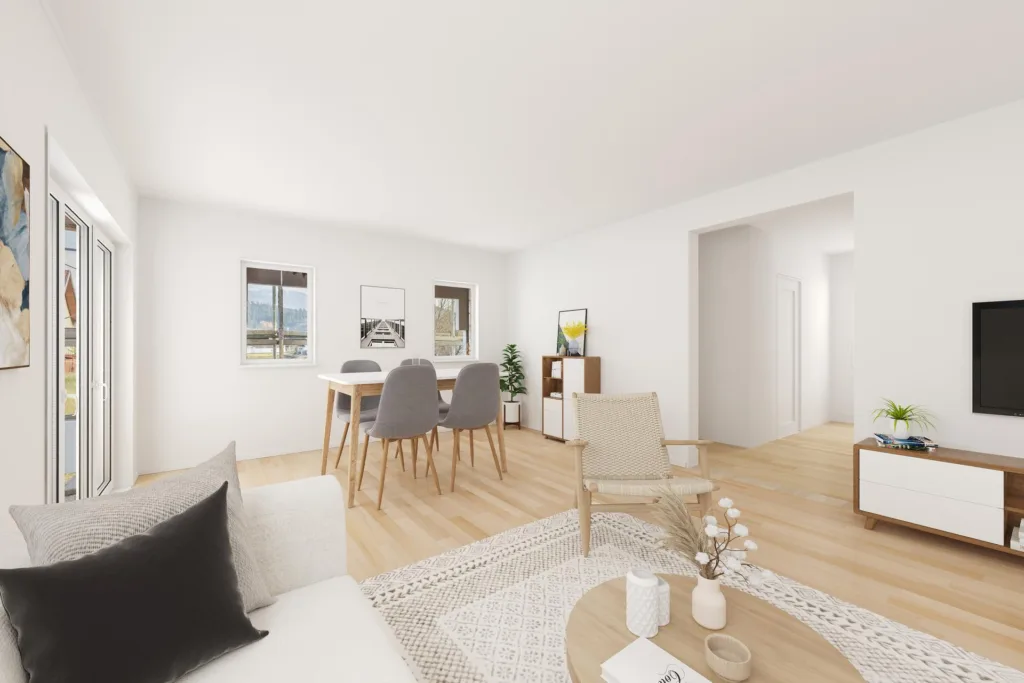
3D Render AI vs. Manual Architectural Rendering: Why the Human Touch Still Matters
Introduction
Architectural rendering has entered a new era. What once took days of manual sketching and digital layering can now be produced in minutes using 3D render AI technology. These artificial intelligence-based rendering tools have revolutionized visualization by reducing time and cost, opening new possibilities for concept exploration and client presentations.
However, while 3D render AI has undoubtedly become a powerful ally, many architects, interior designers, and 3D visual artists still lean heavily on manual rendering techniques—particularly using tools like Adobe Photoshop—to add the final polish. Why is that? The answer lies in creative control, precision, emotional resonance, and trust. This blog explores the ongoing relevance of human craftsmanship in the age of automation and why the architectural industry is far from letting go of manual rendering.
The Critical Role of Visualization in 3D Render AI Projects
Architectural rendering isn’t just about making a project look pretty—it’s a communication tool that turns blueprints and CAD files into immersive, digestible visuals. This visual storytelling is crucial for aligning client expectations, securing regulatory approvals, and driving sales for developers.
3D render AI tools like Midjourney, DALL·E, and PromeAI have made it easier to generate quick concept images with stunning realism. According to a 2024 RenderTech Insights report, 71% of architecture firms reported using AI render tools at least once per project to enhance efficiency.
However, the same report found that 86% of clients preferred visuals that had been manually refined or fully hand-crafted, citing “attention to detail” and “authenticity” as their top priorities. In other words, while AI is great at producing quantity, quality still requires human input.

The Rise and Reach of 3D Render AI in Architectural Visualization
AI rendering platforms have exploded in capability over the last few years. NVIDIA’s GauGAN2, for instance, uses generative adversarial networks (GANs) to turn basic sketches into photorealistic landscapes. Platforms like Lumion and Twinmotion now offer AI-powered features for real-time lighting optimization and texture mapping.
These systems are trained on millions of reference images and architectural styles, allowing them to rapidly construct scenes from basic parameters. According to ArchDaily’s 2023 State of Visualization Report, AI tools helped reduce initial rendering turnaround times by 50–70% in large firms.
Yet speed isn’t everything. AI-generated renderings often lack spatial logic, design narrative, and contextual accuracy. Walls float. Shadows misbehave. Material choices are occasionally impractical. These errors require correction by human designers—proving that AI still needs human guidance to reach professional standards.

Why Photoshop Remains a Pillar in 3D Render AI Workflows
Even when AI delivers a decent draft, the majority of professionals still turn to Photoshop for final edits. Why? Because Photoshop enables pixel-level control that AI simply doesn’t understand.
From precise lighting adjustments to creating natural shadow overlays, from atmospheric haze to reflection tuning—Photoshop allows artists to interpret a space as more than just data. A 2022 CGArchitect survey showed that 73% of visual artists use Photoshop in the final rendering process, regardless of whether the base was generated by AI or manually modeled in software like 3ds Max or Blender.
Photoshop also allows for stylistic customization. Want a watercolor-style rendering or a dreamy twilight scene? AI tools struggle with these kinds of interpretive visuals. Designers, however, can create a unique look that aligns with branding, cultural references, or the emotional tone of a project.

Before: Empty Room

After: Virtual Staging by Digihomestudio.com
Creative Control in 3D Render AI vs. Human-Driven Customization
The biggest limitation of 3D render AI is that it’s algorithmic—it can only draw from the data it has been trained on. This makes it brilliant for rendering generic villas or standard office lobbies but problematic when originality is required.
By contrast, manual rendering allows architects and visualizers to experiment with materials, camera angles, storytelling elements, and lighting moods that are unique to a project. Want to show how afternoon light filters through stained glass onto a stone floor? AI may guess, but a human can make it feel poetic.
For example, when rendering a heritage renovation, a designer might add historical artifacts, aged textures, or references to regional color palettes—all of which AI could overlook. It’s this intentionality that clients notice and value.
Capturing Realism and Human Emotion in 3D Render AI Projects
True realism isn’t just about high resolution. It’s about conveying a feeling of “being there.” Manual renderers excel at adding life to a space—through subtle imperfections, human figures, natural wear, or animated lighting.
AI, on the other hand, often produces visuals that feel “too perfect” or artificially staged. According to a study by DesignIntelligence (2023), clients are 60% more likely to approve a design if the rendering includes imperfections that mirror real-world spaces, such as uneven shadows or aged textures.
Additionally, humans are better at inserting narrative cues: a steaming coffee cup on a table, a dog by the fireplace, curtains fluttering in the breeze. These are not just design flourishes—they create emotional anchors. AI cannot currently replicate that kind of visual empathy.

Before: Empty Room

After: Virtual Staging by Digihomestudio.com
Navigating Design Complexity with Manual Expertise in 3D Render AI Workflows
3D render AI tools work best when fed clean, structured inputs. They excel in minimalist projects and standard layouts. But in large-scale developments, unusual geometry, or culturally complex environments, AI often falters.
Consider a mixed-use tower built on a sloped urban site with sustainability features and local artwork—AI may misplace structural elements, over-simplify sustainability components, or omit critical environmental context.
Manual renderers, however, can adapt to these complexities with precision. They can iterate based on feedback, build custom assets, and adjust scenes to reflect design evolution—ensuring that the visuals evolve alongside the architecture itself.

Render by AI

Render by Digihomestudio.com
Seamless Compatibility: Photoshop’s Role in 3D Render AI Pipelines
Photoshop’s dominance is not accidental—it’s based on years of integration across design ecosystems. Revit, Rhino, SketchUp, and even AI platforms allow export/import into Photoshop formats. This makes it ideal for teams collaborating across tools and departments.
Moreover, 92% of top design schools globally train students in Photoshop as part of their curriculum (source: Architectural Education Quarterly, 2023). This ensures continuity across experience levels and project types.
By contrast, 3D render AI tools often operate as black boxes. Their outputs are harder to reverse-engineer or tweak in collaborative settings. Photoshop, with its layered architecture, gives teams full transparency and control over every pixel—essential for high-stakes presentations.
The Hybrid Workflow: Using 3D Render AI with Manual Polish
The most innovative firms are combining 3D render AI with manual finesse to get the best of both worlds. AI handles the heavy lifting—base renderings, quick ideas, layout iterations—while human designers step in for refinement, storytelling, and customization.
Take the example of ZGF Architects, which implemented a hybrid visualization process in 2023. According to their internal report, this reduced rendering hours by 42%, while increasing client satisfaction scores by 19% due to more emotionally compelling visuals.
This approach acknowledges the power of 3D render AI while respecting the irreplaceable contribution of human creativity. It’s not man versus machine—it’s man guiding machine.
Trust and Persuasion: Why Clients Still Rely on the Human Touch Over 3D Render AI
Trust is central in any design relationship. When clients see a manually crafted rendering, they understand the time, care, and intention behind it. It tells them that the designer has considered every detail—that this isn’t just a computer’s best guess, but a vision grounded in design thinking.
This has direct business implications. Zillow’s 2023 Home Buyer Behavior Report found that listings using custom renderings generated 40% more interest and led to offers 18% faster than those using AI-generated visuals alone.
Clients are not just buying a space—they’re buying a story. And stories are best told by humans.
Suggestions for Professional Photo Editing Services
If you are looking for a professional virtual staging service at an affordable price, Digihomestudio.com is a worthy place for you to trust and accompany. You can expect to invest around $29 for a meticulously designed and lifelike final image, suitable for showcasing your home across various digital platforms.
We have a network of world-class virtual stage editors and designers in Vietnam. To ensure the best level of service, the customer service team is located in the US.
Our virtual home staging services include:
- Staging for empty or furnished rooms
- 2D and 3D floor plans
- Change the color of the walls and floors
- Virtual renovation
- Erase furniture and small objects
- And much more!
If you’re prepared to elevate your real estate marketing strategies, reach out to Digihomestudio.com now and experience the benefits of collaborating with one of the top virtual staging firms available today.

Conclusion: The Enduring Value of the Human Touch in 3D Render AI Era
There’s no denying that 3D render AI has changed the game. Its ability to produce fast, high-quality drafts is a breakthrough for architectural visualization. But in the rush toward automation, we must not lose sight of what makes great design truly resonate: the human element.
Manual rendering offers creativity, emotion, and trust that AI cannot replicate. The most successful workflows today are hybrid—where 3D render AI serves as a powerful assistant, and the human hand provides the soul.
As the design industry continues to evolve, it’s not about replacing people with AI—but empowering artists and architects to create better, smarter, more meaningful spaces. Because in architecture, as in life, it’s the human touch that turns a rendering into a reality worth building.





Leave a Reply